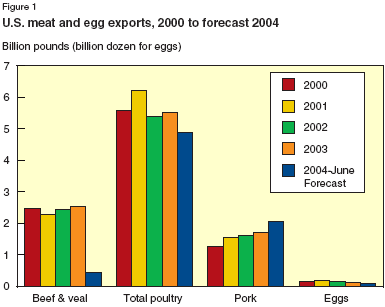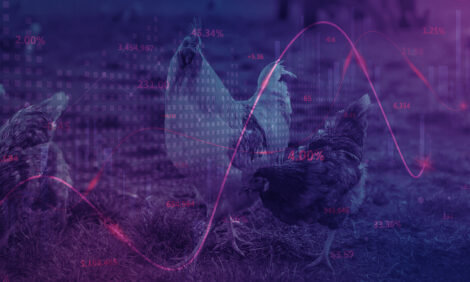



Animal Diseases and Trade Restrictions
By USDA, Economic Research Service - This report looks at US livestock exports and how they have been affected by disease-related trade restrictions.
Abstract
Disease outbreaks and related trade restrictions have slowed previously expected high growth for many U.S. animal-product exports, with U.S. beef exports most affected. U.S. beef exports fell significantly as Japanese consumers avoided purchasing beef following the discovery of BSE in Japan in September 2001. Exports increased after the discovery of BSE in Canada in May 2003 led to worldwide restrictions placed on Canadian beef. They declined in response to restrictions put on U.S. beef exports after the discovery of BSE in the United States in December 2003. The BSE discoveries in the United States and Canada also disrupted North American cattle trade. Export growth for poultry products has been limited over the past several years because of restrictions and culling related to Avian Influenza and Exotic Newcastle Disease. Pork, live hogs, and lamb and mutton have not been directly affected by disease-related trade restrictions, and U.S. pork exports are expected to reach a new record in 2004.
Introduction
The higher export growth of U.S. meat products expected after the world
financial crisis of the late 1990s has been slowed by disease outbreaks and
related trade restrictions.1 While U.S. beef exports were a record 2.5 billion
pounds in 2003, they might have been higher if not for the discovery of
bovine spongiform encephalopathy (BSE) in several Japanese cows since
late 2001.
Japanese consumers significantly reduced their beef consumption
immediately following the discovery of BSE in Japan, unlike North
American consumers, whose consumption of beef was largely unaffected by
the discovery of two cows with BSE, one in Canada in May 2003, and one
in Washington State in December 2003. However, the finding of BSE in that
Canadian-born dairy cow in Washington State resulted in trade restrictions
that have reduced forecast 2004 U.S. beef exports to only 451 million pounds.
Poultry meat exports from the United States totaled 5.5 billion pounds in
2003, 2 percent above 2002 levels. Continuing disease-related problems and
Russian trade policy uncertainty prevented exports from being higher.
Exports are expected to decline more than 11 percent in 2004 because outbreaks
of Avian Influenza (AI) in early 2004 led to bans on U.S. poultry
meat exports. The forecasts here assume there are no additional AI outbreaks
and that current bans on U.S. poultry shipments will be regionalized (limited to
selected geographical regions).
Only U.S. pork exports have shown steady growth over the last several years, in spite of frequent increases in minimum import prices under Japan's pork safeguard system. U.S. pork exports are
expected to reach a record 2.07 billion pounds in 2004. Pork, live hogs, and lamb and mutton have not been directly affected by disease-related trade restrictions, but pork and hogs have faced other types of trade restrictions.

Source: Historical data, U.S. Department of Commerce.
Disease and Sanitation-Induced Trade Restrictions Have Reduced Poultry Meat Exports Since 2002
Expectations that U.S. exports of poultry (broilers, turkeys, and other chicken)
meat in 2003 would greatly exceed 2002 levels did not materialize
because many of the animal health and trade restrictions that reduced poultry
exports by nearly 14 percent in 2002 persisted into 2003. As a result,
poultry exports in 2003 were 5.5 billion pounds, up only 2 percent from
2002.
Since late 2003, the world poultry industry has been affected by outbreaks
of Avian Influenza (AI) in the United States and Southeast Asia, and
associated bans on poultry imports by many countries. In spite of expectations
that current bans by some countries on U.S. poultry exports will be
limited to selected regions of the United States, exports are expected to
decline 12 percent in 2004, placing them 22 percent below the record 6.2
billion pounds achieved in 2001. Broiler meat comprises about 90 percent
of U.S. poultry meat exports.
Disease and sanitation concerns had boosted poultry meat exports in 2001 above trend
The lower exports of U.S. poultry products in 2002 and 2003 followed an
increase in U.S. poultry meat exports in 2001. BSE fears in Europe contributed
to a shift from beef to poultry consumption, both in the EU and
among its trading partners in 2001. Russia had already banned imports of
EU beef in 2000 because of BSE, and Russian consumers continued to shift
their meat demand toward poultry products in 2001. When EU consumers
also substituted consumption of poultry meat for beef, the availability of EU
poultry meat for export to Russia was reduced. As a result, Russian imports
of U.S. broiler meat increased significantly in 2001, accounting for about 40
percent of U.S. broiler exports.
By contrast, 2002 began with Ukraine and Moldova banning U.S. chicken
because of the use of antibiotics in broiler production and microbial rinses
in U.S. processing plants. More important, Russia subsequently banned U.S.
poultry products for the same reasons, in addition to concerns about
Salmonella and plant inspections and certification. Several countries,
including Japan, then banned poultry product imports from specific U.S.
States (which at various times included Pennsylvania, Maine, Virginia, West
Virginia, North Carolina, and Texas) because of outbreaks of low-pathogenic
strains of Avian Influenza.
While world poultry meat imports grew in 2002, it was mainly Brazil,
Thailand, and the EU providing the products. A rebound in beef consumption
in the EU freed up more EU poultry meat for export to Russia and
other world markets late in 2002. Although some growth occurred for the
United States in a number of markets, reduced exports to the three largest
U.S. markets (Russia, Hong Kong/China, and Mexico) dropped U.S. exports
in 2002 below both 2001 and 2000 levels.
As the 2002 AI outbreak was abating, 2003 began with an outbreak of
Exotic Newcastle Disease in California and parts of Arizona and Nevada,
resulting in some regionalized bans on poultry products. This was followed
by an outbreak of AI in Connecticut. But most important, as Russia was
resolving its disease issues with negotiations for a new U.S. plant inspection
protocol, the Russian Government announced a tariff rate quota (TRQ) on
meat imports, effective May 1, 2003. For the months of 2003 that the TRQ
was in effect, the U.S. quota allocation (75 percent of the total TRQ) limited
monthly imports from the United States to about 80 percent of the record
average 192 million pounds achieved in 2001.
Outbreaks of AI in early 2004 in Delaware, Maryland, New Jersey,
Pennsylvania, and Texas have reduced expected poultry meat exports in
2004 to about 4.8 billion pounds. This forecast assumes that disease-related
issues will abate and that importing countries will repeat their previous
practices of regionalizing the bans, thus allowing the United States to export
product from disease-free areas.
Assuming the bans on U.S. poultry products are limited to regions, several
conditions favor U.S. poultry meat exports in 2004. Serious outbreaks of a
highly pathogenic variety of AI in Southeast Asia have taken China and
Thailand temporarily out of the Japanese poultry market, while a highly
pathogenic AI outbreak in Canada may limit that country’s exports.
The inability of the EU to compete in Middle East markets, even with restitutions to reduce its high production costs, suggests that Europe may be a weak competitor on world markets this year. Brazil, however, may be in a strong position to benefit from Asian exporters’ disease problems because of
its low cost structure and relatively weak currency. Strikes by government inspectors in Brazil limited that country’s exports early in 2004.
Egg Exports Decline in 2003 as EU Production Recovers
Nearly 75 percent of U.S. egg exports are typically destined for Canada,
Belgium, Hong Kong, Japan, and Mexico. The main competitors to the
United States on international egg markets are China, India, and the EU.
The bans on U.S. poultry products (including eggs) by Russia, Ukraine, and
Moldova, and the Avian Influenza (AI) outbreaks that reduced poultry meat
exports also contributed to reducing total U.S. egg exports by 8 percent in
2002. The EU also suffered from an outbreak of AI in 2002, concentrated
mainly in the Netherlands, that resulted in the culling of millions of birds
and lower exports. As a result of lower U.S. and EU egg exports, India
gained market share.
U.S. egg exports declined by an additional 16 percent in 2003 as concern
about disease in the United States persisted and EU production increased.
Exports of table eggs decreased in part due to the strong increases in U.S.
egg prices, especially in the second half of 2003. Exports of hatching eggs
rose, as producers in countries such as Mexico were expanding flocks.
Moreover, the outbreak of Exotic Newcastle Disease (END) in southern
California and parts of Arizona and Nevada led to the culling of about 1
million layers (equal to 1 percent of the U.S. laying flock), which limited
the numbers of eggs available for export.
Egg exports are especially sensitive
to supply shifts because only 2 percent of U.S. egg production enters
the export market. In 2004, continuing disease concerns and competition
from China, India, and other low-cost egg-producing countries are expected
to reduce U.S. egg exports about 26 percent, to only 108 million dozen.
Links
To read the full report, please click here (PDF)Source: U.S. Department of Agriculture, Economic Research Service - July 2004








